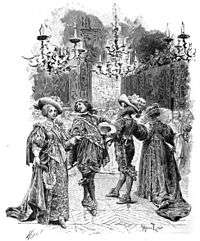Ballet de la Merlaison

The Ballet de la Merlaison is a ballet de cour first performed in 1635 at the Château de Chantilly, during the reign of Louis XIII. It is the most popular ballet performed during the reign of Louis XIII, which marked an important development of the Ballet de cour.
Music
The music of the ballet is considered to be written with the participation of Louis XIII. While some claim he had written only a few airs (Catherine Cressac in L'Orchestre de Louis XIII), most experts consider the entire ballet to be written by Louis XIII (A. Lloyd Moote in Louis XIII, the Just). One thing we know for sure is that Louis XIII made up the story, the choreography and danced himself in the ballet.[1] The music is very typical for the era of Louis XIII, yet it is very interesting for modern musicologists, since it is crucial for the understanding of development from Late Renaissance to Early and High Baroque music.[2]
Trivia
- A full recording of the Ballet de la Merlaison was made in 1967 by Roger Cotte and Jacques Chailley with the Groupe d'instruments anciens de Paris.
- Although the ballet is said to be composed in 1635, André Danican Philidor the elder includes in his "Recueil de plusieurs vieux Airs faites par Philidor l'Aîné" a concert, allegedly composed in 1627, which features the Air "Les Gascons" from the ballet.
- In Alexandre Dumas' "The Three Musketeers" , at the famous ball where the queen recovers the diamond studs she had given to Buckingham, the Ballet de la Merlaison is performed.[3]
However, there are some historical errors: The Ballet de la Merlaison was first performed in 1635 at the Château de Chantilly, whereas this ball takes place at the Hôtel de Ville de Paris, before 1627 (since the Siege of La Rochelle started that year and is described from chapter 24 [The Siege of La Rochelle ] onwards, 12 chapters after the ball had taken place). Also, the Ballet de cour is described as a simple ball (with the men dancing with the ladies), not as a court spectacle which not only included dance, but acting and singing as well.
References
- ↑ A. Lloyd Moote: Louis XIII, the Just; ch. "King and Culture"
- ↑ Catherine Cressac: L'Orchestre de Louis XIII
- ↑ The Three Musketeers; chapter 12, The Ballet de Merlaison: "The ball began. The king turned to the wife of the mayor, with whom he began the dance, and all the other pairs went into their positions behind them. Every time -whilst performing dance figures- he managed to come closer to the queen, he tried to count the diamonds, which were attached to a loop. Yet it wasn't easy and the curiosity of the king left him worried. The Ballet de la Merlaison he enjoyed so much on other occasions, seemed endless to him..."